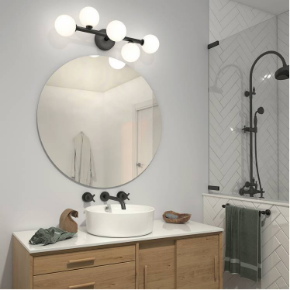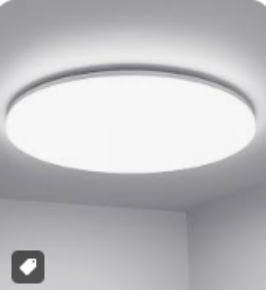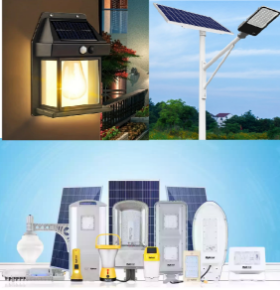Ceiling lights are important for indoor lighting and setting the right mood in your home. Choosing the right types can make a big difference in how usable a room is. It’s essential to pick lights that are functional and fit well with your space. Different ceiling light styles have their advantages and disadvantages, which will help you decide which ones are best for you. If you’re thinking about buying ceiling lights, keep reading this guide until the end.
Good lighting completes the look of your home. Without it, your interior won’t get the attention it deserves. The right types of ceiling lights can brighten up spaces effectively without taking up too much floor space۔ With so many styles to choose from, picking ceiling lighting can be tricky. Finding the right fixture involves thinking about how layers of light and design elements will work together. Understanding the differences between ceiling lights helps you find the perfect fit for your room.

What Are Ceiling Lights?
Ceiling lights come in all shapes, finishes, and sizes. There are overhead fixtures like recessed lights, pendants, and chandeliers, each with its unique style and features. For more details on pendant lights and chandeliers, check out our other buying guides.
Ceiling lights specifically refer to flush and semi-flush fixtures:
- Flush ceiling lights sit close to the ceiling without hanging down. They provide even, ambient light.
- Semi-flush fixtures hang a bit lower, resembling short chandeliers. They also cast ambient light and come in various styles.
Also known as close-to-ceiling lights or overhead lights, flush and semi-flush fixtures are great for lighting up rooms or hallways. They serve as a reliable single light source in smaller rooms or as part of a broader lighting plan. The shades on these lights direct light downward to cover a larger area. The brightness depends on the type of shade used. Some semi-flush lights also create a soft glow against the ceiling, adding a decorative touch to the fixture or the room.
Choosing the Right Size Light for Your Room
In addition to considering layers of light, it’s important to place your ceiling light correctly to ensure it works well and looks professional. This involves determining the height of the light fixture.
One of the most important things to consider is the space underneath the light fixture:
- The clearance below the lowest point of a flush or semi-flush ceiling light should be at least 7 feet.
- If the light is near a doorway, there should be at least 6 inches between the top of the door and the bottom of the fixture.
Professional interior designers use specific formulas to choose the right size and dimensions of ceiling lights for rooms.
To find the ideal height of your ceiling light:
- Measure the height of your room in feet.
- Multiply the room height by 2.5 to get the minimum height in inches.
- Multiply the room height by 3 to get the maximum height in inches.
- Choose a ceiling light within this range.
For example, in an 8-foot room, a flush or semi-flush ceiling light could range from 20 to 24 inches in height when installed against the ceiling.
A similar method applies to determine the dimensions of ceiling lighting for hallways. Instead of height, you'll use the width of the hallway:
- Hallway width (in feet) x 2 = Minimum ceiling light diameter (in inches)
- Hallway width (in feet) x 2.5 = Maximum ceiling light diameter (in inches)
For instance, a 4-foot wide hallway could accommodate a ceiling light with a diameter of 8 to 10 inches.
In larger rooms, you'll use a different formula based on room dimensions:
- Room Width (in feet) + Room Length (in feet) = Maximum ceiling light diameter (in inches)
For a 10x10-foot room, the ceiling light diameter should not exceed 20 inches.
Types of Ceiling Lights:
To achieve proper indoor lighting, you can choose from various types of ceiling lights LED, categorized as hanging and non-hanging types. These lights offer great variety, allowing you to find options that match your home decor. Types include hanging, built-in, and surface-mounted lights.

Chandelier:
Chandeliers are popular for their decorative appeal. They come in many designs suitable for modern, fantasy, or traditional spaces. The number of lamps in a chandelier affects its electricity consumption. Chandeliers are often seen in dining rooms and sometimes in living rooms.
Recessed Ceiling Lights:
These lights are installed within the ceiling, focusing light in one spot. They're good for soft lighting and are often equipped with LED bulbs that can vary in color and power consumption. They're ideal for spaces where you want the lighting to blend with the ceiling.
Surface-Mounted LED Lights:
These lights are mounted on the ceiling and are more visible compared to recessed Ceiling lights. They come in various designs and materials like glass, aluminium, and plastic, offering brighter lighting. They're versatile and suitable for rooms with lower ceilings.
Track Lighting:
Similar to chandeliers, track lighting creates focused light that can be adjusted for brightness. They're often used in kitchens, dining areas, or over desks. Modern track lights are popular for their versatility in interior design.
Ceiling Light with Sensor:
These lights have motion sensors and are used in places where controlling energy consumption is important, like parking lots or corridors. They automatically turn on or off, saving electricity. They come in single or multi-sensor types and are efficient for reducing energy use. Choosing the right ceiling lights enhances your home’s appearance and functionality, making your spaces more appealing and practical.
















